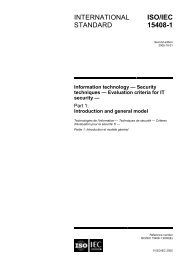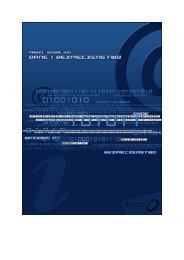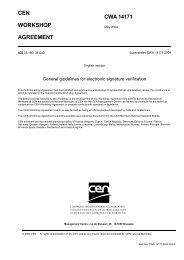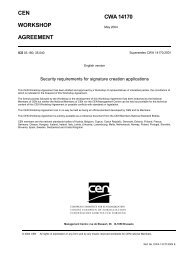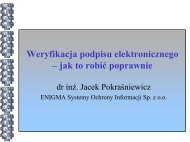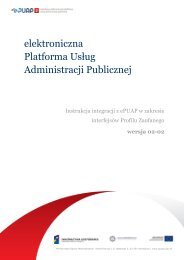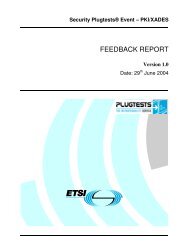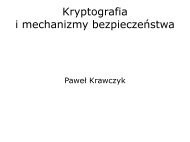When electronic signature becomes a information services ... - IPSec
When electronic signature becomes a information services ... - IPSec
When electronic signature becomes a information services ... - IPSec
Create successful ePaper yourself
Turn your PDF publications into a flip-book with our unique Google optimized e-Paper software.
Now, ZUS knew with the highest confidence assured by a QES that Jan Kowalski purportedly<br />
sent a declaration for Acme, but ZUS did not know what relation Jan Kowalski was to Acme. 60<br />
Jan Kowalski could be the company’s accountant, the external accountant or a complete<br />
stranger, and ZUS had no way to know this. 61<br />
<strong>When</strong> this was first raised as an opportunity for forgery, ZUS correctly explained that it does<br />
not create any reasonable risk of forgery. Shortly after that, ZUS apparently decided that this<br />
gap, however, created a risk for the internal integrity of the data, and in 2009 introduced the<br />
idea that companies start buying attribute certificates 62 to confirm the relation between a<br />
physical person and a legal entity. In the meantime, the Ministry of Internal Affairs and<br />
Administration (MSWiA) announced that ZUS could potentially use a new, non-QES technique<br />
for authentication called a ‘trusted profile’, 63 that should go into production by the end of 2010.<br />
If this works, the QES ‘silver bullet’ 64 for ZUS would make a full circle to the point where it<br />
came from – back on a very bumpy and very expensive road indeed.<br />
Conclusions<br />
The QES does not solve all the issues between the administration, citizens and business<br />
regarding the trust to be given to its use. The qualified <strong>electronic</strong> <strong>signature</strong> is a high security<br />
and expensive technique suitable for relatively small set of business processes, probably<br />
slightly below the notary <strong>signature</strong> in the paper world. Large reports such as CROBIES 65 have<br />
a lot of exciting legal and technical discussions, but no solutions for the simple needs of<br />
citizens that have nothing to do with <strong>information</strong> technology. With the endless theoretical and<br />
legal discussions, it is possible that some EU Member States will continue to discuss a second<br />
or even a third wave of e-signaturism. 66<br />
60<br />
The company name is optional in the Polish qualified certificate profile.<br />
61<br />
Qualified certificates sold in Poland can contain company name but they are not guaranteed, even if the company sponsors the<br />
certificate. At some point, some certification authorities started to discourage certificates with a company name because this would potentially<br />
create issues when a certificate is used for personal purposes.<br />
62<br />
RFC 3281 – An Internet Attribute Certificate Profile for Authorization http://www.ietf.org/rfc/rfc3281.txt. While a X.509<br />
certificate binds an identity to a cryptographic key in a certified manner, the attribute certificates are third-party certified confirmation of<br />
something that the person is allowed to do.<br />
63<br />
‘Zaufany profil’ (‘trusted profile’) – a new single sign-on like technique for identity federation in the public administration<br />
<strong>services</strong>. Little details are known as at the time of writing, but it will be most probably based on non-qualified digital <strong>signature</strong> and SAML<br />
(Security Assertions Markup Language).<br />
64<br />
65<br />
The term ‘silver bullet’ is a colloquial terms that is often used to express the view that the invention will solve all the problems.<br />
CROBIES - Study on Cross-Border Interoperability of eSignatures: http://www.sealed.be/reports.htm.<br />
66<br />
Editor’s note: much of the legal discussion in the reports issued by the EU only concentrate on digital <strong>signature</strong>s (also known as<br />
qualified <strong>electronic</strong> <strong>signature</strong>s), and significantly fail to mention any of the relevant case law relating to all



